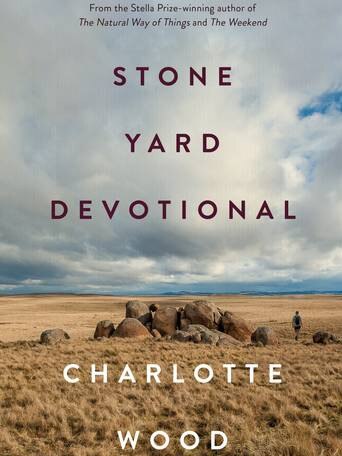Charlotte Wood’s new novel, Stone Yard Devotional, examines the lives of Catholic women
It’s difficult to understate the risks Charlotte Wood has taken in her beguiling and hypnotic new book examining the lives of Catholic women.

It’s possible that some readers regarded Charlotte Wood’s 2016 Stella Prize-winning The Natural Way of Things as the pinnacle of her writing career, but as it happens Wood was just getting warmed up. In Stone Yard Devotional, Wood uses the unorthodox decision of her protagonist to take up a cloistered existence, as a vehicle for examining the casual violence that lies just below the surface of ordinary life.
As we meet our unnamed first-person narrator, she is visiting a nunnery near her home town on the Monaro Plains, described as “shallow, angular plains, bare as rubbed suede.” The quietude of her days there are broken by prayers and meals, and despite her atheism she finds the lifestyle suits her, observing: “The silence is so thick it makes me feel wealthy.”
Soon enough we re-encounter the protagonist who has, rather spectacularly, given up her job at the threatened species centre, unsubscribed from all her email lists, divorced her husband and cut off contact with everyone she knows. She lives with the nuns, cooks for them, and participates in the rituals of their religious existence, though she has not joined the order herself.
Stone Yard Devotional is constructed from the minutiae of the narrator’s day-to-day interactions, yet it is the complexity of human relationships and what they reveal that Wood is most interested in. First, we learn that the bones of a sister who once lived at the nunnery have been located. Sister Jenny died, apparently violently, though there was no investigation into her death. Her bones are to be repatriated by another woman Helen Parry, about whom the narrator retains vivid memories from high school. In the meantime, the Monaro Plains is suffering from a mouse plague of epic proportions, causing the sisters to resort to daily violence to control the population. In one scene, a couple witness mice in a “wide river of silver water flowing steadily beneath them.”

Though it occurred decades earlier, the death of the narrator’s parents remains significant for her: “For many years I felt as though I were breathing and moving through some kind of glue.” Her mother’s compassion for people and the environment is an abiding memory; the narrator recalls her mother’s love for her garden, a place she often “disappeared” to.
The narrator devoted her life to environmental causes, though more recently this has resulted in the narrator’s sense of despair. In one powerful scene, the narrator recalls going to the beach after a “terrible flood” to find it heaving with trash. No matter how much rubbish she pulls out, she sees “the water still roiled and rocked with debris — frightening black branches and other dark shapes.” The violence humans enact on the environment weighs heavily on the narrator’s mind.
Wood’s use of first person is beguiling and hypnotic in its movement between past and present. Although ostensibly structured as a diary, the “I” is not so much self-revelatory, but an “I” that is honest with itself. This narrator openly examines the darker aspects of her personality — her participation in the bullying of another girl in high school, who came from a background of poverty and gave off an aura of “general vulgarity”, but also something “animal and fierce”.
Wood’s use of first person is reminiscent of Elizabeth Strout’s Lucy novels; even the episodic structure seems to take inspiration from those books. But there are also echoes of Marylinne Robinson in that the narrator’s self-scrutiny is involved in the question of what it means to live a moral life.
In one encounter with a sister, the narrator realises that her own strident opinions about the treatment of women within the church has resulted in this sister feeling ridiculed. Chastened, she tells us, “I know what that feels like to have something you cherish ridiculed. It’s a horrible reduction in your sense of yourself”. Cruelties both large and small are what Wood is concerned with here, and the inevitability of suffering in the midst of other people, as much as there is joy in shared experiences. The narrator also recalls the contradictory friendship she held with a woman who was dying of cancer — and how making this woman laugh in their last moments together felt like her “greatest achievement”.
The treatment of the world’s outcasts and dissidents, a role the narrator finds herself inhabiting, is a key preoccupation of this novel. In one scene, a vegetarian woman who attends a wedding where her diet is not catered for, draws the ire of the family by eating a peanut butter sandwich, and “making herself the focus of even this occasion”. Although the narrator is also examining the bonds that draw people together, there is often also a cost to the individual in belonging to a larger group.
In this extraordinary novel, everything resonates and becomes meaningful. Even the mice plague, apparently a freak event, allows Wood to explore the unpleasantness that lies hidden beneath the surface of everyday existence. The mice serve as a reminder of the force of death and decay, a force that the narrator knows at one level is “unstoppable”.
It’s difficult to understate the risks Wood has taken in constructing this book out of apparently minor events. But Stone Yard Devotional is a stunning work of fiction from a major writer who keeps getting better. Although human kindness endures, in Wood’s hands, even cruelty makes its own unexpected contribution to life.
Gretchen Shirm is the author of The Crying Room.



To join the conversation, please log in. Don't have an account? Register
Join the conversation, you are commenting as Logout